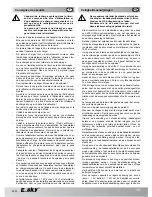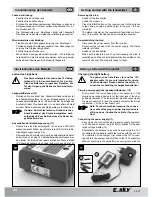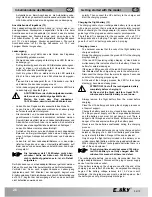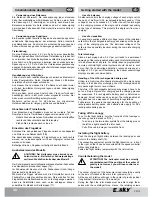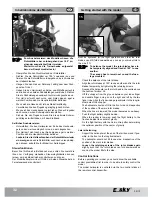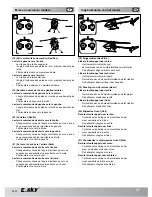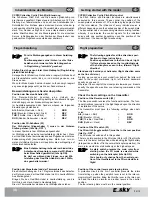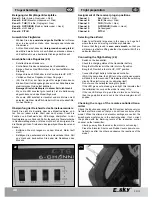
05/10
28
Inbetriebnahme des Modells
Getting started with the model
Der Akku darf nach dem Ladevorgang erst dann
wieder verwendet werden, wenn er abgekühlt
ist. Wenn der Flugakku leer ist, warten Sie mit
dem nächsten Flug mindestens 10 Minuten, bis
sich auch der Antrieb und die Elektronik des
Helikopters abgekühlt hat. Andernfalls kann es
durch die Überhitzung zu einer Beschädigung
des Antriebs und der Elektronik kommen.
Lassen Sie den Akku nicht am Helikopter angesteckt, wenn
Sie ihn nicht benutzen (z.B. bei Transport oder Lagerung).
Andernfalls kann der Akkupack tiefentladen werden. Da-
durch wird er zerstört/unbrauchbar!
Lagern Sie den Flugakku bei Nichtgebrauch an einem küh-
len, gut belüfteten Ort, entfernt von Hitze, brennbaren oder
explosiven Materialien.
Der sichere Umgang mit LiPo-Akkus
Allgemein
Moderne LiPo-Akkus („LiPo“ = Lithium Polymer) verfügen nicht
nur über eine deutlich höhere Kapazität als NiMH- oder NiCd-
Akkus, sie haben auch ein wesentlich geringeres Gewicht. Dies
macht diesen Akkutyp z.B. für den Einsatz im Modellbaubereich
interessant.
Diese Akkus können jedoch sehr schnell durch Tiefentladung,
Überladung und Überlast unbrauchbar werden, darum sind beim
Einsatz dieser Akkutechnik folgende Punkte zu beachten.
Dimensionierung
Je höher der entnommene Strom ist, desto größer ist die
Erwärmung des Akkus und umso geringer wird die nutzbare
Kapazität. Die ideale Betriebstemperatur beim Entladen liegt
zwischen +20°C und +40°C und darf auch unter extremer
Bel60°C nicht übersteigen.
Es besteht Brand- und Explosionsgefahr!
Achten Sie deshalb auf eine ausreichende Küh-
lung im Modell.
Mit wieviel Strom ein Akku kurzzeitig maximal belastet werden
kann, steht entweder in den technischen Datenblättern oder
kann direkt vom Akku abgelesen werden. Dabei bezieht sich der
Wert „C“ immer auf den Kapazitätswert des jeweiligen Akkus.
Beispiel:
Ein Akku mit einer Kapazität von „2100 mAh“ und „20 C“ kann
demzufolge mit maximal 2100 mA x 20 = 42 A belastet werden.
Der maximal zulässige Dauerstrom liegt jedoch deutlich nied-
riger. Wenn keine konkreten Herstellerangaben vorliegen, sollte
der Akku auf Dauer nicht höher als mit ca. 50% des maximal
zulässigen Spitzenstromes belastet werden. Die maximal zuläs-
sige Akkutemperatur von +60°C darf dabei auf keinem Fall
überschritten werden.
Optimales Laden des Akkus
Ein LiPo-Akku muss mit einem speziellen Ladegerät strom-
/spannungsgeregelt geladen werden.
Das bedeutet: Zum Beginn des Ladevorgangs muss der
Ladestrom auf einen Wert von 1 C begrenzt werden. Bei einem
Akku mit 2100 mAh beträgt der Ladestrom dann max. 2,1 A.
Beim Erreichen der maximal zulässigen Ladespannung von
4,2V/Zelle wird die Spannung konstant gehalten und der
Ladestrom geht langsam zurück. Wenn der Ladestrom den
geringsten Wert erreicht hat, ist der Akku voll geladen. Damit bei
der Reihenschaltung einzelner Zellen innerhalb eines Akkupacks
beim Laden keine schädlichen Spannungsüberhöhungen von
mehr als 4,2V/Zelle auftreten können, müssen folgende elektro-
nische Hilfsmittel eingesetzt werden:
-
-
If the flight battery is empty, please wait for at
least 10 minutes before starting with the next
flight to allow the drive and electronic system
of the helicopter to cool down. If this is not
done, this may lead to overheating and cause
consequent damage to the drive and electronic
system.
Never leave the rechargeable battery connected to the he-
licopter if the latter is not used (e.g. during transport or sto-
rage). Otherwise, the battery pack can be fully discharged
and thus get destroyed / become unusable!
When not in use, store the flight battery in a cool and well-
ventilated place away from heat, combustible or explosive
materials.
Proper handling of LiPo rechargeable battery packs
General information
Modern LiPo rechargeable battery packs (“LiPo” = Lithium
Polymer) do not only have a clearly higher capacity than NiMH
or NiCd rechargeable battery packs but they also have a con-
siderably lower weight. That is what makes this type of battery
pack interesting for the use in the field of model construction,
for example.
Nevertheless, these battery packs might become useless due
to total discharge, overcharge and overload. Therefore, the
following points should be noted when using this kind of rechar-
geable battery pack technology:
Dimensioning
The higher the current taken, the greater is the warming of the
battery pack and the lower is the usable capacity. The ideal
operating temperature during discharging is b20°C and
+40°C and must not 60°C even under extreme load.
Danger of fire and explosion! Therefore, always
ensure sufficient cooling in the model.
The maximum short-time current that can be loaded on the bat-
tery pack is stated in the technical data sheets or can be read
directly from the battery pack. The value “C” always refers to the
capacity value of the respective battery pack.
Example:
A battery pack with a capacity of “2100 mAh” and “20 C” can
therefore be loaded with 2100 mA x 20 = 42 A maximum.
However, the maximum permissible continuous current is clearly
lower. If there are no precise manufacturer’s specifications, the
battery pack should not be loaded with more than approx. 50%
of the maximum permissible surge current in the long run. In no
case must the maximum permissible battery pack temperature
of +60°C be exceeded.
Optimum charging of the rechargeable battery pack
A LiPo rechargeable battery pack has to be charged with a spe-
cial current-/voltage-regulated battery charger.
This means: The charging current has to be limited to a value
of 1 C at the beginning of the charging process. A rechargeable
battery pack with 2100 mAh therefore has a charging current of
2.1 A max. When the maximum permissible charging voltage of
4.2 V/cell has been reached, the voltage is kept constant and the
charging current decreases slowly. When the charging current
has reached the lowest value, the battery pack is fully charged.
To ensure that no damaging excess voltages of more than 4.2 V/
cell can develop when charging a seriesconnection of individual
cells within a rechargeable battery pack, the following electronic
tools have to be used:
-
-


